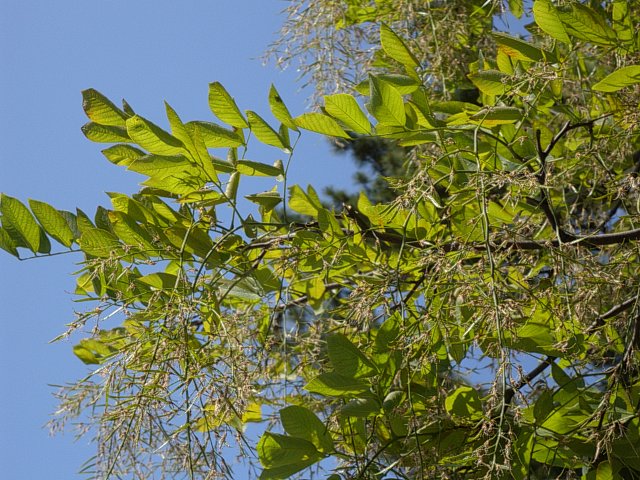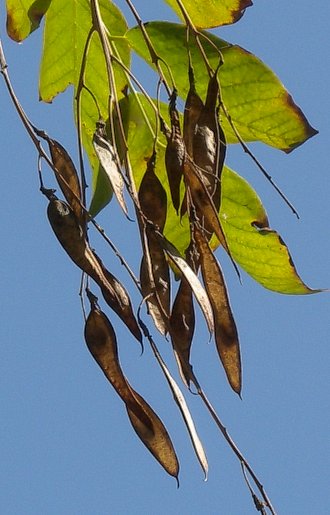
Drooping panicles of white flowers about 6-14" long and 3-6" across develop toward the tips of twigs; they are more broad at their bases than their tips. The branches and pedicels of each panicle are light green and glabrous. Individual flowers are about 1" long; each flower has a pea-like floral structure consisting of an upright banner (upper petal) and 2 forward projecting wings (2 lateral petals) that enclose a narrow keel (2 inner petals that are appressed together). These petals are white. At the base of each flower, there is short tubular calyx with 5 teeth that is light green. The reproductive organs consist of 10 separate stamens and a pistil with a single style. The pedicels are about the same length as the flowers. The blooming period occurs during the late spring for about 2-3 weeks. The flowers are fragrant. Individual trees bloom abundantly about once every 3-4 years. The flowers are replaced by flattened seedpods that are 2-4" long, ¼-¾" across, dark brown, and glabrous at maturity. Each seedpod contains 0-6 seeds; the lateral sides of the seedpods are often undulate and partially constricted between the seeds. The root system of young trees forms a
 taproot.
During the autumn, the deciduous leaves become yellow or golden
yellow.
taproot.
During the autumn, the deciduous leaves become yellow or golden
yellow.Cultivation: Yellow-Wood adapts to full or partial sun, mesic conditions, and soil containing silt or loam. It is not particular about soil pH and can be cultivated north of its natural range. This tree is prone to storm-related damage because the large forking branches that often develop above the trunk are prone to breakage. Therefore, it is best to cultivate this tree in areas that are protected from strong wind. Sometimes, verticillium wilt and other disease organisms can weaken or kill this tree, as can compaction of the neighboring soil from motor vehicles and heavy machinery.
Range & Habitat: The native Yellow-Wood is a rare tree in natural areas of Illinois; it is state-listed as 'endangered' and restricted to the southern tip of the state (see Distribution Map). However, it is sometimes cultivated as a landscape tree. Habitats include rich mesic woodlands in river valleys, lower slopes of wooded bluffs, shaded banks of rivers (above the floodplain zone), and protected rocky coves in mountainous areas. Yellow-Wood is found in high quality natural areas where deciduous trees are abundant. Because of its thin bark, Yellow-Wood is intolerant of fire.
Faunal Associations: Little is known about floral-faunal relationships for this rare tree. The flowers are probably pollinated by bumblebees and other large long-tongued bees. Yellow-Wood is one of the host plants of a leaf beetle, Odontota dorsalis (Locust Leaf Miner); the larvae of this beetle are leaf-miners, while the adults chew holes in the leaves. There is some evidence that an overpopulation of White-Tailed Deer can contribute to the decline of Yellow-Wood in protected natural areas (Mitchell et al., 1997; Lindsey et al., 1969). Young trees, in particular, may be vulnerable to the effects of deer browsing on their leaves and twigs.
Photographic Location: The campus of the University of Illinois in Urbana, Illinois.
Comments: The common name refers to the yellow coloration of the heartwood, which later becomes light brown after it has been cut and dried. It was used to make gunstocks, small decorative furniture, and other specialty items. Yellow-Wood is an unusual tree with smooth bark, showy flowers, and attractive fall coloration. Therefore, it should be cultivated more often.

The bark of Yellow-Wood is almost as smooth as the bark of American Beech (Fagus grandifolia) and European Beech (Fagus sylvatica), but it becomes pebbly with age and is more likely to become covered with lichens and moss. The fragrant white flowers of Yellow-Wood resemble those of Robinia pseudoacacia (Black Locust), but they are arranged in panicles rather than racemes. Unlike many other trees with simple-pinnate leaves, the leaflets of Yellow-Wood are arranged alternately along the rachis of each leaf, rather than oppositely or almost oppositely from each other. This characteristic is quite distinctive. For a species in the Bean family, the flowers of Yellow-Wood are unusual in having 10 distinct stamens, instead of having its stamens united into one (monoadelphous) or two (diadelphous) bundles. This floral characteristic is easier to see after the the petals have detached from the calyx. Sometimes Yellow-Wood is referred to as Cladrastis lutea, which is considered an obsolete scientific name. Meanwhile, its current scientific name, Cladrastis kentukea, is occasionally misspelled as 'Cladrastis kentuckea.'